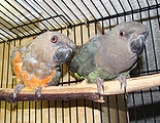
Red-bellied Parrot
Encyclopedia
The Red-bellied Parrot is a small Africa
n parrot
about 23 cm (9 in) long of the Poicephalus
genus. It is a mostly greenish and grey parrot. Males have a bright orange belly and females have a greenish belly.
; Typically, males have a bright orange lower chest and abdomen, whilst adult females are greenish on these lower areas. The dimorphism occurs from a young age and is seen even in young chicks still in the nest.
Africa
Africa is the world's second largest and second most populous continent, after Asia. At about 30.2 million km² including adjacent islands, it covers 6% of the Earth's total surface area and 20.4% of the total land area...
n parrot
Parrot
Parrots, also known as psittacines , are birds of the roughly 372 species in 86 genera that make up the order Psittaciformes, found in most tropical and subtropical regions. The order is subdivided into three families: the Psittacidae , the Cacatuidae and the Strigopidae...
about 23 cm (9 in) long of the Poicephalus
Poicephalus
The genus Poicephalus comprises nine species of parrots native to various regions of the Afrotropic ecozone, including Sub-Saharan Africa, ranging from Senegal in the west, Ethiopia in the east, and to Cape Horn in the south...
genus. It is a mostly greenish and grey parrot. Males have a bright orange belly and females have a greenish belly.
Description
The Red-bellied Parrot is a small parrot about 23 cm (9 in) long. It is a mostly greenish and grey bird with the green being more prominent over its lower surfaces and the grey more prominent over its upper surfaces. Adult birds have green feathers covering the upper portions of their legs, red irises and dark grey beaks. The species is sexually dimorphicSexual dimorphism
Sexual dimorphism is a phenotypic difference between males and females of the same species. Examples of such differences include differences in morphology, ornamentation, and behavior.-Examples:-Ornamentation / coloration:...
; Typically, males have a bright orange lower chest and abdomen, whilst adult females are greenish on these lower areas. The dimorphism occurs from a young age and is seen even in young chicks still in the nest.

